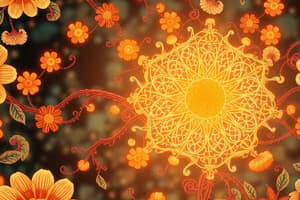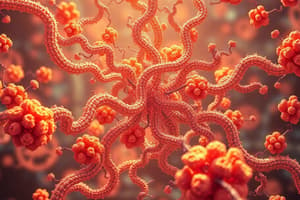Podcast
Questions and Answers
What percentage of total weight does glycogen comprise in the liver?
What percentage of total weight does glycogen comprise in the liver?
- 20%
- 10% (correct)
- 5%
- 2%
Glycogen is a heteropolysaccharide made solely of α-D-glucose.
Glycogen is a heteropolysaccharide made solely of α-D-glucose.
False (B)
What is the role of glycogenin in glycogen's structure?
What is the role of glycogenin in glycogen's structure?
It serves as a protein at the center of glycogen.
Glycogen is primarily broken down into glucose 1-phosphate and __________.
Glycogen is primarily broken down into glucose 1-phosphate and __________.
Match the following functions or components with their respective roles.
Match the following functions or components with their respective roles.
Which enzyme is crucial for the activation of glucose 1-P for glycogen synthesis?
Which enzyme is crucial for the activation of glucose 1-P for glycogen synthesis?
The oxidative reactions of the pentose phosphate pathway are reversible.
The oxidative reactions of the pentose phosphate pathway are reversible.
What are the main products of the oxidative reactions in the pentose phosphate pathway?
What are the main products of the oxidative reactions in the pentose phosphate pathway?
How many protons are pumped by one molecule of NADH in the electron transport chain?
How many protons are pumped by one molecule of NADH in the electron transport chain?
FADH2 enters the electron transport chain from Complex I.
FADH2 enters the electron transport chain from Complex I.
What is the total number of ATP generated from one molecule of glucose during oxidative phosphorylation?
What is the total number of ATP generated from one molecule of glucose during oxidative phosphorylation?
The process of converting pyruvate into glucose is known as __________.
The process of converting pyruvate into glucose is known as __________.
Match the following terms with their descriptions:
Match the following terms with their descriptions:
What percentage of ATP is generated from NADH during glycolysis and TCA cycle combined?
What percentage of ATP is generated from NADH during glycolysis and TCA cycle combined?
The glycerol 3-phosphate shuttle converts NADH to NADH inside the mitochondria.
The glycerol 3-phosphate shuttle converts NADH to NADH inside the mitochondria.
In which cell organelle does the TCA cycle occur?
In which cell organelle does the TCA cycle occur?
1 molecule of glucose during glycolysis produces __________ ATP.
1 molecule of glucose during glycolysis produces __________ ATP.
Which of the following is not a source of blood glucose?
Which of the following is not a source of blood glucose?
Which statement accurately describes bioenergetics?
Which statement accurately describes bioenergetics?
An exergonic reaction has a positive ΔG value.
An exergonic reaction has a positive ΔG value.
What is the role of NADH in metabolism?
What is the role of NADH in metabolism?
The process of converting glucose to glycogen is called __________.
The process of converting glucose to glycogen is called __________.
Match the following metabolic pathways with their corresponding function:
Match the following metabolic pathways with their corresponding function:
Which of the following pathways occurs in the mitochondria?
Which of the following pathways occurs in the mitochondria?
Substrate-level phosphorylation occurs during glycolysis.
Substrate-level phosphorylation occurs during glycolysis.
What is the final electron acceptor in oxidative phosphorylation?
What is the final electron acceptor in oxidative phosphorylation?
The conversion of pyruvate to Acetyl-CoA is an __________ process.
The conversion of pyruvate to Acetyl-CoA is an __________ process.
Match the following forms of ATP production with their description:
Match the following forms of ATP production with their description:
Which of the following is NOT a product of glycolysis?
Which of the following is NOT a product of glycolysis?
The rate-limiting steps in glycolysis regulate the entire process.
The rate-limiting steps in glycolysis regulate the entire process.
What are the two stages of glycolysis?
What are the two stages of glycolysis?
The __________ pathway produces ribose 5-phosphate.
The __________ pathway produces ribose 5-phosphate.
In metabolic reactions, which reaction is considered nonspontaneous?
In metabolic reactions, which reaction is considered nonspontaneous?
Flashcards
Oxidative Phosphorylation
Oxidative Phosphorylation
The process of generating adenosine triphosphate (ATP) using the energy from the movement of protons across a membrane.
Electron Transport Chain (ETC)
Electron Transport Chain (ETC)
A series of transmembrane protein complexes involved in electron transport and proton pumping, ultimately leading to ATP synthesis.
ATP (Adenosine Triphosphate)
ATP (Adenosine Triphosphate)
A molecule produced by cellular respiration that provides energy for various cellular processes.
NADH
NADH
Signup and view all the flashcards
FADH2
FADH2
Signup and view all the flashcards
Pyruvate Dehydrogenase Complex (PDH)
Pyruvate Dehydrogenase Complex (PDH)
Signup and view all the flashcards
Citric Acid Cycle (TCA Cycle)
Citric Acid Cycle (TCA Cycle)
Signup and view all the flashcards
Electron Transport
Electron Transport
Signup and view all the flashcards
Gluconeogenesis
Gluconeogenesis
Signup and view all the flashcards
Glycogen
Glycogen
Signup and view all the flashcards
Glycogen Synthesis
Glycogen Synthesis
Signup and view all the flashcards
Glycogen Degradation
Glycogen Degradation
Signup and view all the flashcards
Muscle Glycogen
Muscle Glycogen
Signup and view all the flashcards
Liver Glycogen
Liver Glycogen
Signup and view all the flashcards
Pentose Phosphate Pathway
Pentose Phosphate Pathway
Signup and view all the flashcards
Oxidative Reactions of Pentose Phosphate
Oxidative Reactions of Pentose Phosphate
Signup and view all the flashcards
Non-oxidative Reactions of Pentose Phosphate
Non-oxidative Reactions of Pentose Phosphate
Signup and view all the flashcards
Bioenergetics
Bioenergetics
Signup and view all the flashcards
Energy difference (ΔG)
Energy difference (ΔG)
Signup and view all the flashcards
Exergonic
Exergonic
Signup and view all the flashcards
Endergonic
Endergonic
Signup and view all the flashcards
Substrate-level phosphorylation
Substrate-level phosphorylation
Signup and view all the flashcards
Glycolysis
Glycolysis
Signup and view all the flashcards
Glycogenolysis
Glycogenolysis
Signup and view all the flashcards
Glycogenesis
Glycogenesis
Signup and view all the flashcards
Citric Acid Cycle (CAC)
Citric Acid Cycle (CAC)
Signup and view all the flashcards
Pyruvate oxidation
Pyruvate oxidation
Signup and view all the flashcards
Study Notes
Bioenergetics
- Bioenergetics is the transfer and utilization of energy in biological systems.
- Bioenergetics predicts if a process is possible, while kinetics measures the reaction rate.
- Enzymes do not change the overall change in energy (ΔG).
Free Energy
- Free energy (G) is useful for determining if a reaction will occur spontaneously.
- A negative ΔG indicates a spontaneous reaction, releasing energy (exergonic).
- A positive ΔG indicates a nonspontaneous reaction, requiring energy input (endergonic).
- Energy difference (ΔG): (Final E) - (Initial E)
ATP Production
- Substrate-level phosphorylation is a direct method of ATP production during a metabolic reaction.
- Oxidative phosphorylation is a process that involves the electron transport chain and chemiosmosis, resulting in the formation of ATP.
- ADP is converted to ATP in both substrate-level phosphorylation and oxidative phosphorylation.
Carbohydrate Metabolism
- Carbohydrates are a primary source of energy for the body.
- Glycolysis is the breakdown of glucose into pyruvate in the cytoplasm.
- Glycogen is a storage form of glucose primarily in muscle and liver.
- Gluconeogenesis is the synthesis of glucose from non-carbohydrate sources.
Glycolysis
- Glycolysis produces ATP directly, NADH (electron carrier).
- Glycolysis provides intermediates for other metabolic pathways.
- Three rate-limiting and regulation steps are involved in glycolysis, to stop or start it based on the need of the cell.
TCA Cycle
- Citrate Cycle (CAC), Tricarboxylic acid (TCA) Cycle, Krebs Cycle are all terms for the same process.
- Pyruvate should be transported to mitochondria for the citric acid cycle process
- It's the link between the end products of glycolysis and further oxidation in the mitochondria.
Oxidative Phosphorylation and ETC
- The Electron Transport Chain (ETC) is a series of protein complexes that use energy from NADH and FADH2 to pump H⁺ (protons) across the inner mitochondrial membrane.
- Electrons are carried from NADH and FADH2 through ETC to cause a proton gradient (flow). ATP is synthesized by using energy of this flow.
Pentose Phosphate Pathway
- Provides important molecules like NADPH and Ribose-5-phosphate.
- It involves both oxidative (irreversible) and non-oxidative (reversible) reactions.
- Ribose 5-P : Nucleotide and Nucleic acid synthesis, and glycolysis intermediates.
- It produces important molecules and is crucial for cell operation.
Glycogen
- Glycogen is a storage form of glucose stored in muscle and liver.
- Glycogenolysis is the breakdown of glycogen to release glucose.
- Glycogenesis is the synthesis of glycogen from glucose.
- Glycogen plays an important role in maintaining glucose levels in the blood.
Gluconeogenesis
- Gluconeogenesis is the process of synthesizing new glucose from non-carbohydrate sources.
- It uses different enzymes and steps compared to glycolysis (opposite path to glycolysis in some places).
- Main differences are enzymes like PEP carboxykinase, and in some steps gluconeogenesis doesn't use the same enzymes.
- Important for maintaining blood glucose levels when other sources are unavailable.
Transfer of Cytoplasmic NADH to Mitochondria
- Two shuttles (Malate-Aspartate and Glycerol 3-phosphate) facilitate the transfer of electrons from cytoplasmic NADH to mitochondrial NAD⁺.
- Key difference between the two shuttles concerns the final electron acceptor (NAD⁺ or FAD⁺). In terms of the net gain of ATP from cytoplasmic NADH, the Malate-Aspartate shuttle produces more ATP than the Glycerol 3-phosphate shuttle.
Studying That Suits You
Use AI to generate personalized quizzes and flashcards to suit your learning preferences.




